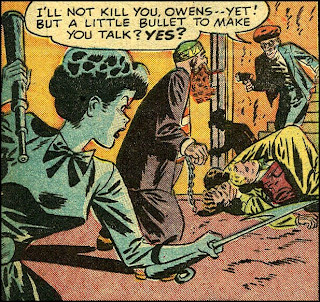The Brave & Bold team-up stories of the 1960s pose a problem for Batman fans. They're bad, but that's not really the crux; there were many bad stories during the Batman Silver Age. The problem is that they were created by writers who weren't familiar with the characters enough, and edited by George Kashdan, who apparently didn't worry too much about little things like continuity or characterization.
The result can be ignored for some of the heroes involved; not many Supergirl or Wonder Woman fans obsess over the ridiculously girlish way they acted in B&B #63. But Batman has a tougher time, because there are so many Batman teamups from 1966 on that it constitutes a significant body of work.
There are some stories that must be either ignored or palmed off as involving Batman from Earth II. How else can you explain Bruce Wayne appearing as an adult in WWII London? Answer: You can't. It was ludicrous in the 1960s; now of course it would make him an 80-year-old codger.
Let's look at Brave & Bold #64 for an example of the horrific characterization that typified these stories.
In the story Batman improbably rescues a gal about to be shot by a bowman using his rope:

She faints and they recognize each other:

"But why was that bow buzzard trying to ventilate your beautiful torso?" Timeless dialogue!
Okay, so we get the inevitable flashback. Seems Marcia was a beautiful but spoiled rich bitch, and Batman had both rescued and tamed her:

Batman assumes that's the end of it, but she has different ideas:

Why, yes, I'd be happy to have a crack shot on my team, never mind that my parents were gunned down by a crook. And before you know it, when they're not busting up crime gangs, they're steaming up the windows of the Batmobile. But then she dumps him, which brings us up to the point where they rediscover each other.
Now, that's pretty horrific characterization for Batman. Dumped by a society chick? We learn that she went on to become engaged to another man, named Nicky. Nicky was determined not to live off her inheritance, so he... became a thief. Say what? He's too noble by half!
Well, you can see the problem already, right? Here's Batman mooning over a gal who dumped him for a lowlife. But it gets even worse. She wants him to return a jewel that Nicky stole before he died (she's available again). Batman returns the emerald, but is surprised that the newspapers haven't remarked on its return. Then it turns out that the commissioner has received a photograph of Batman returning the gem, but it looks like he's taking it. He agrees to go to jail pending trial (huh?) but that doesn't prevent another teary-eyed scene:

With Batman in jail, we learn (sort of) the real plot. Marcia is actually a crook working for a syndicate known as Cyclops. She has managed to free Eclipso from the body he shares with Dr Bruce Gordon (hmmmm, Bruce Gordon?) so that he can join her on a criminal rampage throughout Gotham City. But it turns out that Marcia has been forced to work for Cyclops because they threatened to kill her dad. So it's okay that she dumped our hero, because she did it for family. Sheesh!













































